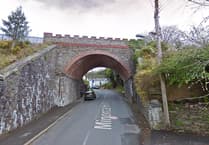Passengers on board a tram which careered out of control down Snaefell mountain have welcomed news that failsafe back-up brakes are to be fitted.
The Department of Infrastructure was last month fined £18,000 after admitting five health and safety breaches in relation to the runaway tram incident in August 2017.
None of those charges related to the braking system - despite the fact that the incident occurred when power was lost to the tram’s rheostatic brakes.
Disaster was averted only when the crew managed to stop the vehicle with its manual brake - but only after it had swept across the road at the Bungalow with dozens of passengers on board.
Now it has been confirmed that an improvement notice has been served on the DoI obliging it to fit ’fail to safe’ on the trams by March 31 - that is, before the Snaefell Mountain Railway opens for the 2019 season.
Nick Douglas, from Belfast, was one of the passengers on board the runaway tram alongside his wife Tricia, son Luke and five-year-old grandson Elijah. He said: ’I’m delighted the safety of passengers is being taken this seriously. I look forward to seeing how it is implemented. Well done Railway Inspectorate.’
Another passenger Karen Taylor, also welcomed the move.
She said: ’I am immensely relieved that there has been an improvement notice served on the SMR to install failsafe brakes by the start of the 2019 season.
’The incident on August 4, 2017 can only be described as a near-miss and 50 people nearly lost their lives.
’Fitting failsafe brakes, among the other improvements that have been made, will save 50 lives in the future. Without these steps the railway was unsafe.
’The department has still not issued an appropriate apology to the passengers involved, referring to the incident as causing ’upset’.
’It was, instead, a terrifying ordeal in which we nearly lost our lives and has caused huge distress to those on the tram.’
She added: ’I would like to see a formal apology accepting that this was a major incident and also some recognition that after care should have been offered to the passengers.
’I would like to know that SMR staff have now been trained in how to care for passengers after such an incident.’
The Health and Safety at Work Inspectorate improvement notice, dated April 11 last year but only just now made public, states: ’Significant improvements to equipment, maintenance procedures and operating instructions made following the investigation of an incident on the railway on August 4, 2017 have - subject to the application of appropriate maintenance and operational standards - significantly improved the levels of safety on Mountain Railway services.
’However, investigation of the incident by an independent railways engineer has identified that the installation of a fail to safe braking system would be a reasonably practicable measure.
’As no fail to safe systems are currently installed on Mountain Railway trams they are not therefore constructed to a level that is as safe as reasonably practicable.’
The improvement notice was issued after services on the line resumed for the 2018 season, having previously been subject to a prohibition notice.
It states that the DoI has to install a fail to safe braking system to each SMR tram and ensure each is tested to a documented test regime.
No tram will be allowed to enter service in the 2019 season unless a report demonstrating successful commissioning has been completed and supplied to the HSWI.
Passengers services cannot begin until at least two trams have been successful fitted with tested and commissioned fail to safe brakes.
Failure to comply with the improvement notice could result in a £20,000 fine on summary conviction.
Services on the SMR were suspended on September 25, 2017, some seven weeks after tram no.2 ran away from the summit station.
On October 11 that year, the HSWI served a prohibition notice halting all operations pending a review of all safety critical equipment including the rheostatic control system and fell brake.
Details of that prohibition notice have also been released for the first time.
It states there was a risk of ’serious personal injury’ and that the maintenance arrangements for ensuring the safe operation of ’safety critical’ tram control and braking systems were not adequate.
The rheostatic brakes depend on a continuous air and electricity supply but can on occasion cut out if the tram loses contact with the overhead wire.
A spokesman for the DoI said work is currently ongoing to install a fourth braking system in addition to those already fitted.
He said: ’Maintenance improvements and design enhancements to the three separate existing braking and control systems were implemented as a consequence of the investigation.
’The development of the additional fail to safe track braking system was recommended by industry specialists and supported by the HSWI in preparation for the 2019 season.’
The DoI said in a statement after last month’s court case: ’We know that the incident caused a great deal of upset and would like to apologise to those on board at the time.’




